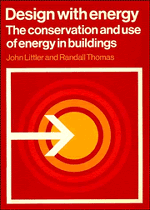Book contents
- Frontmatter
- Contents
- Units, symbols, abbreviations, conventions and conversion factors
- Preface
- 1 Energy and buildings
- 2 Site planning and analysis
- 3 Building design
- 4 Passive solar design
- 5 Active solar heating
- 6 Space heating and ventilation
- 7 Thermal storage
- 8 Wind energy
- 9 Water-supply systems
- 10 Waste disposal and utilization
- 11 Domestic-energy saving
- 12 Housing case studies
- 13 Non-domestic case studies
- Appendix 1 Weather data
- Appendix 2 Thermal performance
- Appendix 3 Interstitial condensation
- Index
3 - Building design
Published online by Cambridge University Press: 03 February 2010
- Frontmatter
- Contents
- Units, symbols, abbreviations, conventions and conversion factors
- Preface
- 1 Energy and buildings
- 2 Site planning and analysis
- 3 Building design
- 4 Passive solar design
- 5 Active solar heating
- 6 Space heating and ventilation
- 7 Thermal storage
- 8 Wind energy
- 9 Water-supply systems
- 10 Waste disposal and utilization
- 11 Domestic-energy saving
- 12 Housing case studies
- 13 Non-domestic case studies
- Appendix 1 Weather data
- Appendix 2 Thermal performance
- Appendix 3 Interstitial condensation
- Index
Summary
Introduction
Le Corbusier[1] said that a house was a machine for living in – in this chapter we attempt to describe some of the machine's components. Unfortunately, the state of the art is such that, for a given set of inputs, say environmental and material, one isn't quite certain how the machine or building will perform. The heart of our present dilemma is that we cannot precisely say even how individual building components respond in situations outside laboratories. To take but one example, infiltration losses are difficult to determine because of the effect of workmanship, condition of seals, extent of exposure to wind and so forth. And, remembering the old adage: ‘The best laid plans of mice and men …’, if we consider that, even in a well-designed low-energy house, the occupants will undoubtedly use the house in ways that would amaze the designers, the description of a building's performance is a hazardous task indeed. What is even more difficult though is to make accurate recommendations about how to design different, more-energy-efficient buildings. Of course there are the banal (but worthwhile) solutions such as increasing the insulation level and decreasing the ventilation rate but, as we will see, the latter can only be done to a certain point which is well short of the one where occupants and designer breathe uneasily. For more-complex questions such as choosing between lightweight and heavyweight buildings our information is imperfect. And as for other areas which may become the technology of tomorrow, evacuated walls, say, we know almost nothing.
- Type
- Chapter
- Information
- Design with EnergyThe Conservation and Use of Energy in Buildings, pp. 42 - 96Publisher: Cambridge University PressPrint publication year: 1984

